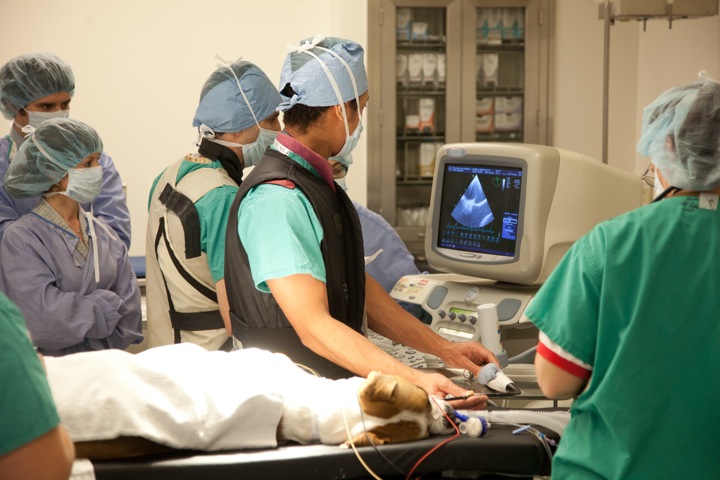Patent Ductus Arteriosus
CAUSE:
Patent ductus arteriosus (also called PDA) is a birth defect in the heart. It is caused by incomplete changes in the heart's circulation when a dog or cat is born. The ductus arteriosus is an important blood vessel that ensures that blood does not go to the lungs unnecessarily as the fetus is developing in the uterus. During the first few hours after birth, this blood vessel naturally closes off. This allows blood to travel normally through the lungs for oxygenation as the lungs begin to function when the puppy or kitten takes its first breath. In some puppies and kittens, the ductus arteriosus remains open (patent). This results in serious, life-threatening changes in the way that the heart pumps blood through the heart and to the rest of the body
CLINICAL SIGNS:
As the disease process progresses heart failure can ensue which include sings of shortness of breath, coughing, weakness, and exercise intolerance.
DIAGNOSIS:
Most cases of patent ductus arteriosus are found when a perfectly healthy-looking puppy or kitten is brought to the veterinarian for a routine examination, and a heart murmur is detected. A heart murmur is the sound produced by blood moving through the heart in a turbulent fashion and can be heard by the veterinarian by using a stethoscope. If there is a concern that the murmur may indicate a patent ductus arteriosus (these PDA murmurs produce a very distinctive sound), then tests are warranted to evaluate the possibility of patent ductus arteriosus. Usually, x-rays are taken of the chest to evaluate the size and shape of the heart and to evaluate the lungs. An electrocardiogram (ECG) depicts the pattern of electrical activity in the heart and any irregularities in the heart's rhythm (arrhythmias). The ECG may show changes that support a diagnosis of a PDA. An echocardiogram, (cardiac ultrasound), is the test of choice for a PDA. An image of the inside of the heart is displayed on a monitor in real time and allows the cardiologist to observe the abnormal communication between the aorta and pulmonary artery.

PROGNOSIS:
Having a patent ductus arteriosus is not usually compatible with a normal life span unless the patent ductus arteriosus is corrected (closed).
TREATMENT/PROCEDURE:
The goal of treatment is to close the ductus arteriosus. This can be accomplished through thoracotomy (an open-chest surgery) or through cardiac catheter-based (minimally-invasive surgery) occlusion. Thoracotomy is more invasive because the chest is opened, but unlike humans, most dogs lose all outward signs of pain in 1 or 2 days after chest surgery. Catheter based occlusion (closing the duct with coils or a ductal occlude) is a minimally-invasive alternative and the patients usually go home the following day. It requires specialized equipment, and may not be appropriate for cats and smaller dogs. It is important that one of these two procedures is performed as soon as possible after the diagnosis is made. In some cases, waiting too long allows other very serious complications to develop and creates the need for even more extensive treatment. Your veterinarian will recommend a veterinary cardiologist or surgeon to perform either of these procedures.
FOLLOW UP EXAMINATIONS:
This will depend on the procedure that was used to correct the PDA. If a thoracotomy is performed the sutures will have to be removed in 7-10 days. Make sure bandages, chest wraps, and stitched incisions (sutures) stay clean and dry after surgery. If they become wet, are chewed at or damaged by the pet, or otherwise seem abnormal, contact your veterinarian for a recheck to reduce the risk of infection or other problems. If catheter based occlusion is performed, sutures will also have to be removed in 7-10 days. Usually, a repeat echocardiogram is acquired 1-3 months post PDA closure. Long-term follow-up appointments may occasionally be needed if there was any possibility of long-standing effects (permanent damage) to the heart or if your animal is taking any cardiac medication.


